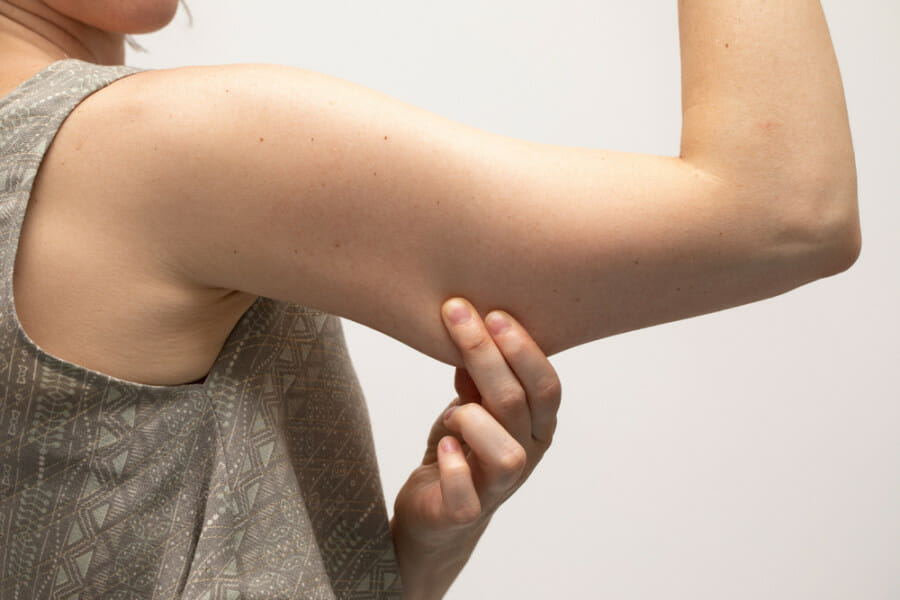Skin Dysmorphia Is a Very Real Mental Health Concern: Study Says
As an 11-year-old sixth-grader in the early aughts, Danielle Kent, now a publicist based in Los Angeles, began fixating on her skin. She would carry a makeup bag with her at all times to “fix” her perceived flaws at any given moment.
“I would be doing touch-ups during class or running to the bathroom between periods to make sure I looked okay,” she says. “I thought that if I wasn’t checking in and seeing what I looked like between these class periods, then somehow my face would completely distort and look different from how I wanted it to look.”
As she got older, she began waking up at 6 a.m. so she could spend hours getting ready for school. Still, she’d dip into the bathroom several times a day to make sure she continued to look okay—and she took care to hide this habit from her peers.
“I didn’t feel comfortable talking to other people about what I was going through because when you’re constantly looking at yourself, people perceive that as vanity,” she says. “People would think I was looking in the mirror all day because I thought I was hot s**t, but in reality, I was just checking to make sure I didn’t look different [than I had before].”
But Kent wasn’t being vain or self-conscious—she was dealing with skin dysmorphia. And now, with the modern omnipresence of social media apps and recent proliferation of video conferencing, experts believe the condition has become even more prevalent. London-based psychodermatologist Alia Ahmed, MD, says, “I am absolutely seeing a rise in cases.”
What is skin dysmorphia?
First and foremost, it’s important to understand that “skin dysmorphia” is a colloquial term, not a clinical diagnosis; the psychiatric term for it is body dysmorphic disorder (BDD).
“BDD happens when there is a preoccupation with one or more perceived flaws in physical appearance that are not observed by others or are perceived as very slight by others,” says dermatologist and psychiatrist Ladan Mostaghimi, MD, director of the Wisconsin Psychocutaneous Clinic. She adds that this preoccupation is most frequently directed toward the skin, hair, and nose, but can also focus on muscles or other areas of the body. BDD involves compulsively obsessing over a perceived flaw, which is either nonexistent or slight in reality, leading to a notable decline in quality of life.
According to psychiatrist and BDD expert Katharine Phillips, MD, BDD affects between 2 to 3 percent of the population (though it is likely underreported)—and the majority (around 60 percent) of those impacted identify as women. While BDD can present at any age, Dr. Phillips says that the average age of onset is around 16 or 17.
“The best studies of the clinical features of body dysmorphic disorder show that 73 percent of people with body dysmorphic disorder have skin concerns.”
Katharine Phillips, MD
According to a 2022 study published in the British Journal of Dermatology, symptoms of BDD were five times more prevalent in patients with dermatological conditions. “Thus far, the best studies of the clinical features of body dysmorphic disorder show that 73 percent of people with body dysmorphic disorder have skin concerns,” Dr. Phillips says, hypothesizing this may underpin the popularization of the term skin dysmorphia.
Dr. Phillips’ book, The Broken Mirror: Understanding and Treating Body Dysmorphic Disorder, includes research concluding people with skin-centric BDD often obsess over perceived acne and scarring and other types of marks on their face, and also the color of their skin (for example, thinking it’s too red or too white). “But virtually any aspect of the skin can be disliked—facial pores that are considered unusually large, veins, capillaries, wrinkles, sagging, shriveling, and stretch marks,” she says.
While Dr. Phillips says there is no singular cause of BDD, there may be a significant genetic component. In other words, like many other mental health conditions, risk for the disorder is inherited. Environmental factors may also contribute to the development of BDD, but she says identifying those factors and knowing their extent requires additional scientific research. “It may be things like being teased about your appearance, it may be childhood abuse, it may be certain forms of social media—but it’s very hard to study,” she says.
How BDD differs from other body-image concerns
It’s important to distinguish between BDD (skin-focused body dysmorphic disorder or otherwise) and appearance-related insecurities, the latter of which affects far more people than BDD does.
“Most people have body-image concerns, but we don’t want to label 90 percent of the population with a psychiatric disorder,” says Dr. Phillips. “We have to draw a somewhat imperfect, but very important, line between sub-clinical concerns—meaning [a line between] those not warranting a psychiatric diagnosis and the psychiatric diagnosis.”
In addition to a preoccupation with skin quality consuming at least one hour of an individual’s day, cumulatively, it must lead to clinically significant distress or impairment in functioning, as Dr. Mostaghimi noted earlier.
“Examples of emotional distress are anxiety, low mood, depression, feelings that life isn’t worth living, embarrassment, shame—a whole host of negative emotions,” says Dr. Phillips. “Examples of impairments in day-to-day functioning can include things like not concentrating as well because you’re obsessing about how your skin looks and very extreme impairments like people not leaving their house for years because they think they look ugly and don’t want people to see them.”
While someone with non-clinical skin concerns may critique themselves during a Zoom call—and even buy a cream or book a facial afterward—they won’t continue to obsess outside of that specific moment the way someone with BDD would, says Dr. Ahmed.
BDD patients will also engage in certain obsessive rituals not seen in those with non-clinical body-image issues. “[BDD patients] perform repetitive behaviors in response to their appearance concerns, so they’ll check mirrors a lot, they’ll compare themselves to others, they’ll engage in skin picking, and some will frequently research cosmetic or dermatologic procedures online,” says Dr. Phillips.
Kent says the slightest imperfection or blemish would make her feel “disgusting” and remembers frequently begging her mom to let her stay home from school because of how she felt she looked. “People with body dysmorphic disorder are actually visually perceiving themselves differently than other people see them,” says Dr. Phillips. “They worry that there’s something very wrong with how they look, that they look abnormal in some way or that they look deformed. Sometimes more extreme terms are used, like ‘monstrous’ or ‘hideous.’ In reality, these people look normal.”
Ultimately, says Dr. Phillips, those with clinical BDD have a distorted view of their appearance that is not aligned with reality. Whereas no one likes having a pimple, when someone with BDD or skin dysmorphia, gets a pimple, they may believe the pimple makes them unfit to be seen in public.
And while body image issues can diminish mental health, BDD is downright dangerous. “Body dysmorphic disorder is associated with very high rates of suicidal thinking, high rates of suicide attempts, and high rates of actual suicide,” says Dr. Phillips.
Why BDD and skin dysmorphia may be on the rise
Unfortunately, good data on the prevalence of BDD is difficult to find, says Dr. Phillips. “Big, population-based prevalence studies are hard and expensive to do. We haven’t had a good one since 2015,” she says. What’s more is that many studies mislabel non-clinical body-image issues as “dysmorphia” (think: Zoom or Snapchat dysmorphia), which means they aren’t actually studying clinical BDD at all.
While technology and social media can contribute to the development of BDD—and can exacerbate its emergence for people who have some of the other risk factors listed below—the facial fixations that can come along with using these platforms don’t constitute a clinical BDD diagnosis on their own.
Still, both Dr. Phillips and Dr. Ahmed suspect that BDD is becoming more common, even if underdiagnosed officially. And because skin concerns are among the most common fixations of those who have BDD, skin dysmorphia is likely becoming more prevalent, too. The experts are able to hypothesize why this may be, pointing to several risk factors that may be at increased play, though in isolation will not unilaterally cause BDD.
Social media
While social media alone will not cause BDD, the experts say it can certainly function as a risk factor. Dr. Mostaghimi points out research showing that social media use leads to an increase in body dissatisfaction. “Looking at heavily edited images, especially if the viewer is unaware that the images are edited, could increase dissatisfaction with one’s body and increase unrealistic beauty standards,” she says. Other research shows that regular exposure to exaggerated features, like lips plumped with filler, can cause a shift in what people find attractive. This could lead to a distorted view of one’s natural physical features, which could contribute to dysmorphia, a focus on skin, or on other attributes.
“Looking at heavily edited images, especially if the viewer is unaware that the images are edited, could increase dissatisfaction with one’s body and increase unrealistic beauty standards.”
Ladan Mostaghimi, MD
However Dr. Phillips notes that studies connecting the dots between social media and clinical BDD versus body-image issues, are hard to come by. One small 2020 study out of Saudi Arabia did show that BDD was “significantly associated” with a longer duration spent on Snapchat and Instagram, though researchers pointed out that more studies with larger sample sizes are needed in order to assess the association. Another study, published in JAMA Facial Plastic Surgery in 2018 suggested that filtered images could exacerbate BDD, and Dr. Ahmed says she’s seen evidence of this connection in her practice. “These filters are just tragic,” she says. “They make you think, ‘I could look like that’ when the effects are actually unachievable in real life.”
People with BDD are more likely to use image-centric forms of social media to validate their appearance as well, says Dr. Phillips. “They tend to go online and change their appearance with various apps and compare themselves to others, especially with celebrities,” she says. “These repetitive behaviors are very toxic, and they tend to keep the appearance-based obsessions going. Typically, they cause a lot of distress.”
For Kent, that distress comes as a result of not being able to control images she isn’t editing and posting herself. “Other people taking pictures of me completely freaks me out,” she says. “I worry the photo is going to get posted all over the internet and people will see it in my tagged photos and then they’ll be like, ‘Look at Danielle, she’s so ugly.’”
Video conferencing
One Harvard survey of 7,000 people found that those who’d spent the most time on Zoom had the worst perception of their own appearance. To Dr. Ahmed, this tracks: When you’re on a video conference call, you’re staring at yourself for prolonged periods of time, which isn’t something you’d normally do in real life. This can cause you to become more aware of issues with your skin or facial features, and to feel as though they’re more noticeable to others than you thought.
This negative perception is exacerbated by the way computer cameras distort your appearance, for example, making your nose look bigger and your eyes look smaller, says Dr. Phillips.
Stress
As is the case with many mental health conditions, stress can be a trigger or risk factor for BDD, and many people’s stress levels have increased exponentially in the past few years. “The pandemic and social isolation have been a big source of stress for everyone, especially young people,” says Dr. Mostaghimi. “It has also increased the use of social media as the preferred way of communication. This will need further epidemiological studies, but there are reports pointing toward the aggravation of BDD during the pandemic.”
Societal pressures
The cultural fixation with youth may also be contributing to facial dysmorphia. Dr. Ahmed says many of her patients seek to correct what she calls “age-appropriate skin,” and may have a distorted view of how they look as a result. “There is this age-related dysmorphia, where the normal process [of aging] has been made to feel abnormal, and you feel so guilty or ashamed to look the age that you are,” she says.
While Dr. Phillips emphasizes that the term “age-related dysmorphia” is not a clinical diagnosis, she agrees that BDD can involve an obsessive focus on aging skin. “We don’t really know if sensitivity about aging and unrealistic expectations about aging are causing BDD to be more common, but this is quite possible,” she says.
Pervasive ageism in society has been shown to lead to mental health issues related to normal aging, but Dr. Phillips says that an individual would have to meet all the criteria in order to be diagnosed with BDD.
How to treat skin dysmorphia
“If anybody is spending an excess of time thinking about a skin issue, and it’s impacting their quality of life, they should seek a professional opinion,” says Dr. Ahmed.
One of the most common and effective treatments for BDD is cognitive behavioral therapy (CBT). In it, “you learn how to evaluate your thoughts and develop more accurate and helpful thoughts,” says Dr. Phillips. “You learn strategies to stop all those repetitive behaviors, like checking yourself online or checking mirrors or comparing yourself with others or skin picking, and you also learn how to feel more comfortable going out and being around other people.”
When BDD is severe, Dr. Phillips says CBT may be used alongside medication to treat patients. Selective serotonin reuptake inhibitors (SSRIs), are commonly prescribed to people with BDD. With them, “symptoms usually improve substantially,” she says. “People aren’t as distressed, they aren’t as depressed, suicidality often improves, and functioning often improves.”
And while dermatologists will certainly treat skin conditions that actually exist in a patient with BDD—like acne, for example—Dr. Phillips and her colleagues do not recommend these patients undergo cosmetic procedures. “For people with BDD, it usually doesn’t help, and it can make things worse,” she says. As another example, if there’s scarring from skin picking, Dr. Phillips says she may treat that, but only after a patient has undergone treatment for their underlying dysmorphia first.
Because BDD can be a life-threatening illness, self-treatment is not advised; however, Dr. Ahmed says certain resources that can be used in conjunction with professional help. She recommends checking out the Body Dysmorphic Disorder Foundation as well as the Body-Focused Repetitive Behaviors website. “They’ll have a lot of tips and tricks on there that you can try,” she says. “For skin picking, for example, they might recommend making tweezers inaccessible or giving them to someone who you trust who you’ll have to ask them for so you’re less likely to [harm your skin].”
What’s most important, though, is to be honest with yourself about what’s happening so you can take steps to get help. “People are often very ashamed of their appearance concerns and don’t want others to know that they’re so focused on their appearance,” says Dr. Phillips. “Maybe they’re afraid they’ll be considered vain or superficial, or they don’t want to draw more attention to what they think looks really ugly.”
But BDD is not vanity—it’s a mental health disorder that needs to be taken seriously.
Well+Good articles reference scientific, reliable, recent, robust studies to back up the information we share. You can trust us along your wellness journey.
-
- Nicewicz HR, Boutrouille JF. Body Dysmorphic Disorder. [Updated 2022 Sep 28]. In: StatPearls [Internet]. Treasure Island (FL): StatPearls Publishing; 2023 Jan-. Available from: https://www.ncbi.nlm.nih.gov/books/NBK555901/
-
- Schut, C., et al. “Body dysmorphia in common skin diseases: results of an observational, cross-sectional multicentre study among dermatological outpatients in 17 European countries*”. Br J Dermatol, 187 (2022): 115-125. https://doi.org/10.1111/bjd.21021
-
- Bjornsson, Andri S et al. “Body dysmorphic disorder.” Dialogues in clinical neuroscience vol. 12,2 (2010): 221-32. doi:10.31887/DCNS.2010.12.2/abjornsson
-
- Li, Wei et al. “Body Dysmorphic Disorder: Neurobiological Features and an Updated Model.” Zeitschrift fur klinische Psychologie und Psychotherapie (Gottingen, Germany) vol. 42,3 (2013): 184-191. doi:10.1026/1616-3443/a000213
-
- Phillips, Katharine A. “Suicidality in Body Dysmorphic Disorder.” Primary psychiatry vol. 14,12 (2007): 58-66.
-
- Buhlmann, Ulrike , et al. “Updates on the Prevalence of Body Dysmorphic Disorder: A Population-Based Survey.” The Journal of Lifelong Learning in Psychiatry, 2015, https://doi.org/10.1176/appi.focus.130217.
-
- Goldie, Kate et al. “Aesthetic Delusions: An Investigation into the Role of Rapid Visual Adaptation in Aesthetic Practice.” Clinical, cosmetic and investigational dermatology vol. 14 1079-1087. 26 Aug. 2021, doi:10.2147/CCID.S305976
-
- Alsaidan, Mohammed Saud et al. “The prevalence and determinants of body dysmorphic disorder among young social media users: A cross-sectional study.” Dermatology reports vol. 12,3 8774. 22 Dec. 2020, doi:10.4081/dr.2020.8774
-
- Maymone, Mayra B C, and George Kroumpouzos. “Incorporation of social media questions in body dysmorphic disorder scales: A proposed revision.” Clinics in dermatology vol. 40,5 (2022): 554-555. doi:10.1016/j.clindermatol.2022.02.015
-
- Manchia, Mirko et al. “The impact of the prolonged COVID-19 pandemic on stress resilience and mental health: A critical review across waves.” European neuropsychopharmacology : the journal of the European College of Neuropsychopharmacology vol. 55 (2022): 22-83. doi:10.1016/j.euroneuro.2021.10.864
-
- Kang, Hyun, and Hansol Kim. “Ageism and Psychological Well-Being Among Older Adults: A Systematic Review.” Gerontology & geriatric medicine vol. 8 23337214221087023. 11 Apr. 2022, doi:10.1177/23337214221087023
- Phillips, Katharine A, and Eric Hollander. “Treating body dysmorphic disorder with medication: evidence, misconceptions, and a suggested approach.” Body image vol. 5,1 (2008): 13-27. doi:10.1016/j.bodyim.2007.12.003

















